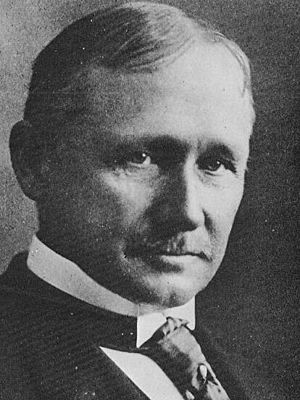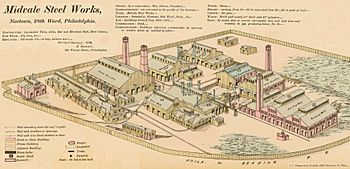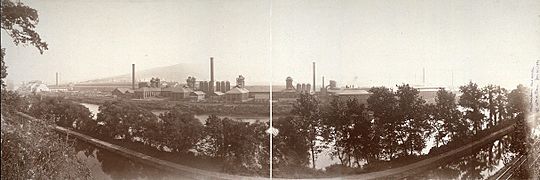Frederick Winslow Taylor facts for kids
Quick facts for kids
Frederick Winslow Taylor
|
|
|---|---|

Taylor circa 1907
|
|
| Born | March 20, 1856 Philadelphia, Pennsylvania, U.S.
|
| Died | March 21, 1915 (aged 59) Philadelphia, Pennsylvania, U.S.
|
| Resting place | West Laurel Hill Cemetery Bala Cynwyd, Pennsylvania, U.S. |
| Education | Phillips Exeter Academy |
| Alma mater | Stevens Institute of Technology (BS) |
| Occupation | Efficiency expert Management consultant |
| Known for | Father of scientific management, efficiency movement and industrial engineering |
| Spouse(s) | Louise M. Spooner |
| Children | 3 |
| Awards | Elliott Cresson Medal (1902) |
Frederick Winslow Taylor (born March 20, 1856 – died March 21, 1915) was an American mechanical engineer. He is famous for his ideas on how to make factories and businesses work better. He was one of the first people to offer advice as a management consultant.
In 1909, Taylor wrote a book called The Principles of Scientific Management. In this book, he explained his ideas for improving efficiency. This book was later voted the most important management book of the 20th century. His work helped create a field of engineering called industrial engineering. Taylor's ideas are sometimes called Taylorism.
Contents
About Frederick Winslow Taylor
Frederick Taylor was born in 1856 in Germantown, Philadelphia, Pennsylvania. His family were Quakers. His father, Franklin Taylor, was a lawyer. His mother, Emily Annette Taylor, worked to end slavery.
Taylor was taught by his mother when he was young. He also studied in France and Germany. In 1872, he went to Phillips Exeter Academy. He planned to go to Harvard and become a lawyer. But in 1874, he had problems with his eyesight. This changed his plans.
Instead of Harvard, Taylor became an apprentice. He learned to be a patternmaker and a machinist. This gave him hands-on experience in factories. In 1878, he started working at Midvale Steel Works.
At Midvale, Taylor quickly moved up. He became a time clerk, then a machinist, and later a machine shop foreman. He even became the chief engineer. His family's connection to Edward Clark, a part-owner of Midvale Steel, helped his quick rise.
When Taylor worked as a laborer, he noticed something important. Workers were not using their machines or themselves as efficiently as they could. This practice was called "soldiering" at the time. It made labor costs very high for the company.
When Taylor became a foreman, he wanted more output from the workers. He started to study how men and machines worked. He wanted to find the best way to do tasks. This focus on making work more efficient became known as scientific management.
While at Midvale, Taylor was also a talented athlete. He and Clarence Clark won the first tennis doubles tournament in the 1881 US National Championships. This event was the start of the US Open.
Taylor also studied by mail at Stevens Institute of Technology. He earned a degree in mechanical engineering in 1883. In 1884, he married Louise M. Spooner.
From 1890 to 1893, Taylor worked as a manager for a company that ran paper mills. In 1893, he started his own consulting business. He helped companies improve their factory management and costs. During this time, he made his management system even better.
In 1898, he joined Bethlehem Steel. There, he helped solve a problem with their machine shop. He also made a very important discovery. Between 1898 and 1900, Taylor and Maunsel White found that adding tungsten to steel made it cut much faster. This invention earned them a lot of money.
Taylor left Bethlehem Steel in 1901. He was now a wealthy man. He spent the rest of his life sharing his ideas through lectures, writing, and consulting. His ideas became very famous around the world in 1910.
In 1906, the University of Pennsylvania gave Taylor an honorary degree. He also became a professor at the Tuck School of Business at Dartmouth College. Frederick Taylor died in 1915 from pneumonia, one day after his 59th birthday. He is buried in West Laurel Hill Cemetery.
Taylor's Scientific Management
Taylor was a mechanical engineer who wanted to make factories work better. He is known as the "father of scientific management". He was one of the first management consultants.
According to Peter Drucker, a famous business thinker, Taylor was the first person to truly study how work is done. Drucker said that Taylor's "scientific management" helped create a huge increase in wealth. This wealth improved the lives of working people in many countries.
Taylor's scientific management had four main ideas:
- Instead of old ways of working, use methods based on scientific study.
- Carefully choose, train, and develop each employee. Don't just let them train themselves.
- Give workers clear instructions and supervision for each task.
- Share work equally between managers and workers. Managers plan using scientific principles, and workers do the tasks.
A lawyer named Louis Brandeis first used the term scientific management in 1910. He argued that railroads could be more efficient using Taylor's ideas. Taylor then used this term in his famous book, The Principles of Scientific Management.
Managers and Workers in Taylor's System
Taylor had strong ideas about how to use his system. He believed that managers had to make sure workers followed the best methods. This included using the right tools and working conditions. He felt that managers were responsible for making sure everyone cooperated.
Taylor believed that workers should be chosen carefully for each job. He thought that some jobs needed very simple, repetitive tasks. For these jobs, he believed that people who were "mentally alert" would find the work too boring.
Taylor wanted managers to have more control over how work was done. He wanted to separate the thinking (planning) from the doing (manual labor). Managers would create detailed plans. These plans would tell workers exactly how to do their jobs.
Sometimes, workers did not like Taylor's system. It led to many strikes. For example, a strike at Watertown Arsenal led to a government investigation in 1912.
Taylor believed in fair pay for workers. He thought that pay should be linked to how much a worker produced. Workers using his system could earn more money than others. This sometimes made factory owners who didn't use his system unhappy.
Studying Work Efficiency
Taylor believed that by carefully studying work, there was "one best way" to do any task. He is famous for developing the stopwatch time study. This method, combined with Frank Gilbreth's motion study methods, became known as time and motion study.
He would break down a job into small parts. Then, he would measure how long each part took, down to a hundredth of a minute. One famous study involved shovels. He noticed workers used the same shovel for everything. Taylor found that the best amount to shovel was 21½ pounds. He then designed shovels that would scoop this exact amount for different materials.
Even though his ideas were sometimes hard to put into practice, his followers helped spread them. His book, Shop Management, also sold very well.
Taylor's Impact and Legacy
Taylor's ideas had a big impact on many people and industries.
- Carl G. Barth helped Taylor create special slide rules. These rules helped calculate the best speeds for machines. These types of tools are still used today.
- H. L. Gantt created the Gantt chart. This is a visual tool that helps schedule tasks and show how work flows.
- Harrington Emerson brought scientific management to the railroad industry.
- Lillian Gilbreth and Frank Gilbreth studied human motion in work. Their work combined with Taylor's time studies to form time and motion study.
- Harvard University started offering a business management degree in 1908. Its first-year studies were based on Taylor's scientific management.
Influence in Other Countries
Taylor's ideas spread beyond the United States.
- In France, Le Chatelier translated Taylor's work. Scientific management was used in government factories during World War I.
- In Great Britain, engineers and managers were very interested in Taylor's ideas. Companies like Cadbury and Seebohm Rowntree used his methods.
- In the Soviet Union, Vladimir Lenin was very impressed by Taylorism. He and other leaders tried to use it in Soviet factories.
The Taylor Society
The Taylor Society was started in 1912 by Taylor's supporters. They wanted to promote his ideas. After Taylor died, the society grew to 800 members. Many top U.S. business leaders were members. In 1936, the society merged with another group to form the Society for Advancement of Management, which still exists today.
Criticism of Taylor's Ideas
Not everyone agreed with Taylor's methods.
- Some critics, like Antonio Gramsci, argued that Taylorism gave too much power to managers. They felt it made workers less important.
- Harry Braverman argued that scientific management made work less skilled and more boring.
- Management expert Henry Mintzberg said that focusing too much on efficiency can ignore important social benefits.
- Some socialists believed Taylor's methods made work worse for employees. They felt it made work repetitive and took away workers' skills.
Even Japanese business leaders, like Kōnosuke Matsushita, criticized the "Taylor model." They believed that businesses needed to use the intelligence of all workers, not just managers, to succeed in a complex world.
Tennis and Golf Achievements
Frederick Taylor was also a talented athlete. He was a good tennis and golf player. In 1881, he and Clarence Clark won the first United States National tennis doubles championship. At the 1900 Summer Olympics, Taylor finished fourth in golf.
| Result | Year | Championship | Surface | Partner | Opponents | Score |
|---|---|---|---|---|---|---|
| Win | 1881 | U.S. Doubles Championships | Grass |
|
6–5, 6–4, 6–5 |
See also
 In Spanish: Frederick Winslow Taylor para niños
In Spanish: Frederick Winslow Taylor para niños
- C. Bertrand Thompson




